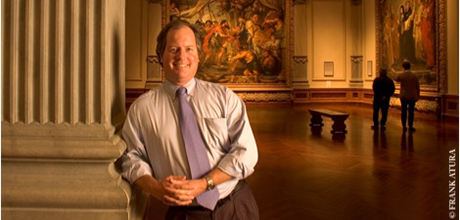John Wetenhall has been named director of the George Washington University Museum and The Textile Museum. He will lead development of the forthcoming university museum as well as transition The Textile Museum to GW’s Foggy Bottom Campus in fall 2014. Dr. Wetenhall will begin his tenure on June 1 and will also hold the appointment of associate professor of museum studies.
“John Wetenhall will take the lead in shaping a new kind of museum for GW. This is a one-of-a-kind partnership, and we are confident that he will create a cultural destination that will be a leader in academic and cultural communities in D.C. and around the world,” said Steven Lerman, GW provost and executive vice president of academic affairs. “His accomplishments in both the academic and artistic fields make him the ideal person to connect the strong traditions of scholarship and art in the new museum.”
Dr. Wetenhall was named director following a 10-month national and international search by representatives from GW and The Textile Museum. He previously served in executive leadership roles at the Carnegie Museums in Pittsburgh; the John and Mable Ringling Museum of Art in Sarasota, Fla.; and the Cheekwood Museum of Art in Nashville.
He received a Ph.D. from Stanford University, an M.B.A. from Vanderbilt University, a master’s degree from Williams College, and a bachelor’s degree from Dartmouth College.
He has served as a curator of European, American and contemporary art, and as an art historian. He has taught at Stanford University, Santa Clara University and the University of Minnesota, and has been a featured speaker at numerous professional conferences.
Dr. Wetenhall said he was excited to join two institutions working to form a powerful affiliation.
“The opportunities to showcase The Textile Museum’s rich cultural collections and to engage students, faculty and researchers at the George Washington University are unprecedented,” he said.
“The Textile Museum is internationally respected for its global collection, important exhibitions and scholarly publications. George Washington University is renowned for its outstanding programs in museum studies and museum education, as well as its rich collection documenting the nation's capital,” Dr. Wetenhall said. “The new museum creates at once a campus laboratory for museum training and innovation, while also presenting important art and historical artifacts of profound importance to both Washington, D.C., and the world. This is a magnificent professional opportunity and a chance to contribute meaningfully to the museum field.”
Bruce Baganz, president of The Textile Museum’s board of trustees, said Dr. Wetenhall’s experience is a good fit for the challenges he’ll face in helping to shape a new institution.
“John Wetenhall has the background to blend business and art, which are key needs for 21st-century museums,” Mr. Baganz said. “With his broad experience in the museum field, tremendous stature and entrepreneurial approach, we are positive that John will steer the new museum into an era that takes full advantage of the artistic, cultural, academic and technological assets that this partnership provides. His experience in successfully transitioning the John and Mable Ringling Museum of Art to Florida State University is a testament to his ability to introduce the key strengths of The Textile Museum to the campus community.”
The new George Washington University Museum will include dedicated galleries and increased exhibition space for The Textile Museum, the Albert H. Small Washingtoniana Collection and the university’s art collections. Exhibitions and programs will be presented to the public and will involve GW faculty and students in academic collaborations.
Robert Perry, a member of George Washington’s Board of Trustees and a participant on the search committee, said he believes the new museum will be a draw for both scholarly audiences and general visitors.
“As a longtime admirer of Albert Small’s Washingtoniana Collection and as a proponent for the new museum, I am thrilled to have someone of Dr. Wetenhall’s caliber as its director,” he said. “This is a rare opportunity to have a museum in the nation’s capital that will be a destination museum for scholars, students and the public.”
Dr. Wetenhall serves as vice chair and treasurer of the American Alliance of Museums and chairs nominations for the U.S. National Committee of the International Council of Museums. In 2010, Dr. Wetenhall received the Museum Service Award from the Southeastern Museums Conference and the Florida Association of Museums’ Lifetime Achievement Award.
Once at GW, The Textile Museum will continue its existing programs and exhibitions, in addition to fostering new opportunities for research and public engagement. The Textile Museum will continue management of its collections of more than 19,000 pieces, which encompass the textile arts of peoples across the Near East, Central Asia, East and Southeast Asia, Africa and the indigenous cultures of the Americas. The 20,000-volume Arthur D. Jenkins Library of Textile Arts also will be housed in the new museum on GW’s Foggy Bottom Campus. The museum’s exhibition “Out of Southeast Asia: Art that Sustains,” opening April 12 and on view through Oct. 13, will be the final exhibition in the museum’s current S Street location.
George Washington University and The Textile Museum held a groundbreaking for the new museum in October 2012. The museum will be a custom-built building located at G and 21st streets, NW, and is expected to be completed by fall 2014. A conservation and collections resource center at GW’s Virginia Science and Technology Campus in Ashburn, Va., also is under construction and will be completed in late 2013.


